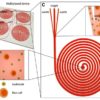Short tandem repeat (STR) typing (DNA fingerprints) is the existing gold standard for human forensic identification – easily performed with high-quality, single-contributor genetic samples. The DNA typing technique provides a reliable, rapid and sensitive analysis for parentage testing, forensic identification, and medical diagnostics. However, for evidence samples collected from a crime scene – the amount of DNA retrieved could be at a low concentration due to contributions from multiple individuals (cells, tissue, DNA). Resulting challenges include mixed genotypes in complex biological samples with more than one contributory DNA sample and the preferential amplification of a victim’s DNA compared to a perpetrator’s much rarer cell type. As a result, to reduce the challenges, a variety of strategies were developed to separate diverse cell populations prior to analysis. Techniques include microfluidics-based methods, microchip-based separation, micromanipulation, and laser capture microdissection. Limitations specific to the methods include their complexity, low efficiency, low throughput, lack of versatility and a high likelihood of cross-contamination.
As a result, scientists are interested in developing improved methods for single-cell forensic amplification. One such technique is “Monodisperse Microdroplets” an innovative technique where miniature droplet reactors can be produced using state-of-the-art microfluidics technology to allow for high-sensitivity analysis. Such systems can provide reaction volumes in droplets ranging from the femtoliter to the microliter. In the setup, single cells are housed in discrete aqueous droplets surrounded by an immiscible carrier oil to limit cross-contamination. The microfluidic system can control the droplet size, uniformity and the internal content (such as reagent composition and concentration) to engineer a precise microenvironment for the desired experiment. The microfluidics droplet technology can be used to conduct large-scale independent reactions in parallel, to screen millions of single cells for a specific trait or criminal character. The experiments also allow cell heterogeneity probing to detect rare cells, for applications where a perpetrator has a rarer cell type. The described technology can use single-cell PCR (polymerase chain reaction) to analyze DNA from single cells in forensic cases where only minute or dilute quantities of mixed evidence material are available.
Another drawback to the STR gold standard method is its inability to quickly respond with DNA analyses in situations where delays could impede decisions. For instance, in booking stations and at the border crossing, faster-to-results DNA analysis can benefit forensic investigations. A new method known as Rapid DNA technology aims to address this challenge by integrating samples in a combined DNA index system (CODIS). The setup can generate compatible DNA profiles in less than 90 minutes. The “RapidHIT ID 200” systems were developmentally and experimentally validated for applications in the UK National DNA databases where more than 1000 STR profiles were uploaded. The next-generation microfluidics instrument was specifically developed to address needs in such environments necessitating faster-to-results DNA analyses. In the experimental setup, bulk reagents and a capillary electrophoresis module can be housed inside a plastic compartment, resembling a printer toner-like primary cartridge (GlobalFiler®)for minimum stability of 6 months at 250C. When an STR profile is generated, the “RapidHIT ID” system can transfer the data to a central computer to process and manually review profiles via the “RapidLINK” software (IntegenX).
The system contains a built-in fingerprint reader and camera to authenticate, access and automate tracking. Experiments are designed in accordance with quality assurance standards of the Federal Bureau of Investigation (FBI) and guidelines of the Scientific Working Group for DNA analysis methods. It is possible to use the RapidHIT technique to yield complete and consistent DNA profiles. For example, highly reliable size precision can be acquired for male and female donor samples, even with minute sample quantities of one touch to the cheek, to identify individuals in order facilities, booking stations and for general laboratory use. In this way,next-generation microfluidics platforms in forensic science aim to facilitate automation and high-throughput processing. The techniques will allow minimal sample contamination alongside rapid identification of dilute, rare or minute samples in self-contained microfluidic platforms.
The experimental platforms detailed here were designed to validate quality assurance standards, offering results in a familiar, conventional STR format. The technologies can be transferred from the lab to the industry. Rapidly advancing microfluidic techniques in molecular biology are thus facilitating fast forensics to crossover from fictional labs to real-time practice. The ready accessibility of forensic science and genetics across the years is highlighted by ongoing outreach efforts that can facilitate a hands-on experience in cutting-edge molecular biology, in a forensics lab for young scientists via workshops. Improved sensitivity and selectivity with microfluidics and capillary electrophoresis systems can refine the scientific method for higher precision. Future work will extend to analyze real-world dilute, contaminated and mixed samples (low-abundance and rare materials) within such platforms for forensic investigations.
Enjoyed this article? Don’t forget to share.

Thamarasee Jeewandara
Thamarasee Jeewandara is an Early Career Scientist and Science Writer, with a Ph.D. in Medicine and Bioengineering from the Sydney Medical School, University of Sydney, Australia. She is currently living in New York, focusing on her research and writing interests in materials science, tissue engineering, and bone research. Find her on Twitter @Jeew333T and her science writing portfolio on Nature Research Bioengineering.





